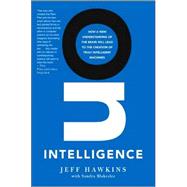
On Intelligence
by Hawkins, Jeff; Blakeslee, SandraBuy New
Buy Used
Rent Book
eBook
We're Sorry
Not Available
How Marketplace Works:
- This item is offered by an independent seller and not shipped from our warehouse
- Item details like edition and cover design may differ from our description; see seller's comments before ordering.
- Sellers much confirm and ship within two business days; otherwise, the order will be cancelled and refunded.
- Marketplace purchases cannot be returned to eCampus.com. Contact the seller directly for inquiries; if no response within two days, contact customer service.
- Additional shipping costs apply to Marketplace purchases. Review shipping costs at checkout.
Summary
Author Biography
Sandra Blakeslee has been writing about science and medicine for The New York Times for more than thirty years and is the co-author of Phantoms in the Brain by V. S. Ramachandran and of Judith Wallerstein's bestselling books on psychology and marriage. She lives in Santa Fe, New Mexico.
Table of Contents
Let me show why computing is not intelligence. Consider the task of catching a ball. Someone throws a ball to you, you see it traveling towards you, and in less than a second you snatch it out of the air. This doesn't seem too difficult-until you try to program a robot arm to do the same. As many a graduate student has found out the hard way, it seems nearly impossible. When engineers or computer scientists try to solve this problem, they first try to calculate the flight of the ball to determine where it will be when it reaches the arm. This calculation requires solving a set of equations of the type you learn in high school physics. Next, all the joints of a robotic arm have to be adjusted in concert to move the hand into the proper position. This whole operation has to be repeated multiple times, for as the ball approaches, the robot gets better information about its location and trajectory. If the robot waits to start moving until it knows exactly where the ball will land it will be too late to catch it. A computer requires millions of steps to solve the numerous mathematical equations to catch the ball. And although it's imaginable that a computer might be programmed to successfully solve this problem, the brain solves it in a different, faster, more intelligent way.
Excerpts
Excerpted from On Intelligence by Jeff Hawkins
All rights reserved by the original copyright owners. Excerpts are provided for display purposes only and may not be reproduced, reprinted or distributed without the written permission of the publisher.
An electronic version of this book is available through VitalSource.
This book is viewable on PC, Mac, iPhone, iPad, iPod Touch, and most smartphones.
By purchasing, you will be able to view this book online, as well as download it, for the chosen number of days.
Digital License
You are licensing a digital product for a set duration. Durations are set forth in the product description, with "Lifetime" typically meaning five (5) years of online access and permanent download to a supported device. All licenses are non-transferable.
More details can be found here.
A downloadable version of this book is available through the eCampus Reader or compatible Adobe readers.
Applications are available on iOS, Android, PC, Mac, and Windows Mobile platforms.
Please view the compatibility matrix prior to purchase.
